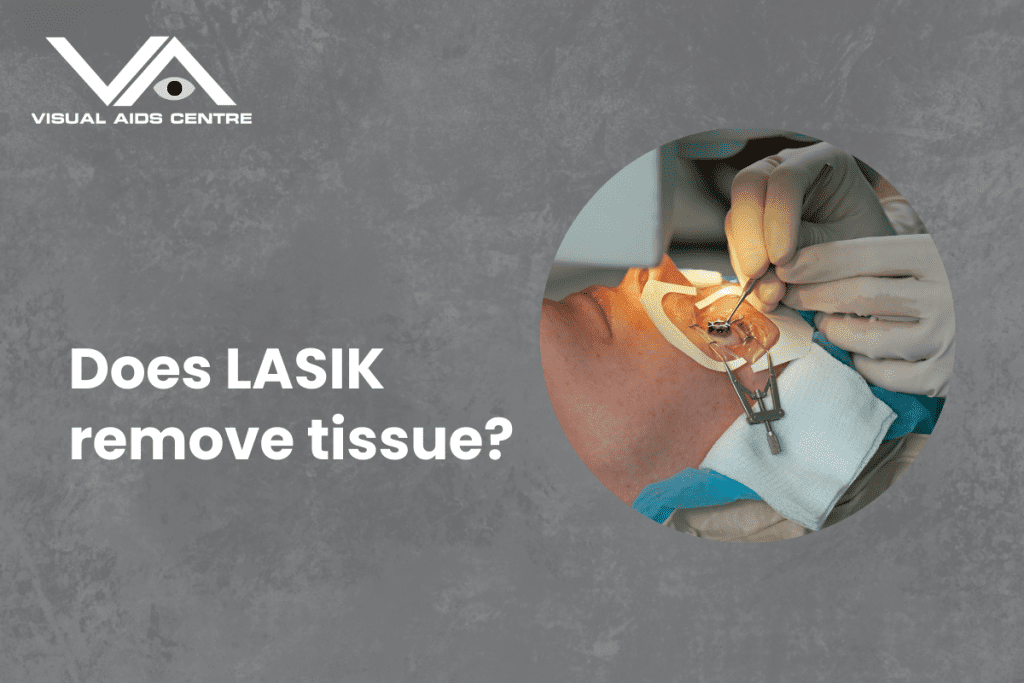Table of Contents
ToggleLaser-assisted in Situ Keratomileusis (LASIK) is one of the most popular vision correction procedures, widely chosen by individuals seeking freedom from glasses and contact lenses.
One of the primary concerns among those considering LASIK is whether the procedure involves removing tissue from the cornea. The answer is yes—LASIK does remove corneal tissue but in a precise and controlled manner. Understanding how and why this happens can help individuals make informed decisions about their vision correction options.

How Does LASIK Reshape the Cornea?
LASIK reshapes the cornea to correct refractive errors such as myopia (nearsightedness), hyperopia (farsightedness), and astigmatism. During the procedure, a laser removes microscopic amounts of corneal tissue to alter its shape and improve how light focuses on the retina. The amount of tissue removed depends on the severity of the vision problem and the desired correction.
Why Is Tissue Removal Necessary in LASIK?
The human eye relies on the cornea and lens to bend (refract) light onto the retina, creating clear vision. When the shape of the cornea is irregular, light does not focus properly, resulting in blurry vision. LASIK removes precise layers of corneal tissue to reshape the surface and correct these errors, allowing light to focus correctly. The goal is to achieve a more accurate vision without needing corrective eyewear.
How Much Corneal Tissue Does LASIK Remove?
The amount of tissue removed during LASIK varies depending on the individual’s prescription. On average, the laser removes about 15 to 20 microns of corneal tissue per diopter of correction. To put this into perspective, human hair is approximately 50 to 100 microns thick, meaning LASIK removes only a fraction of that.
Does the Type of LASIK Affect Tissue Removal?
Different LASIK techniques can influence how corneal tissue is removed:
- Traditional LASIK: A microkeratome blade creates a flap before reshaping the cornea with a laser.
- Bladeless LASIK (Femto-LASIK): A femtosecond laser creates the flap, offering more precision and preserving more corneal tissue.
- PRK (Photorefractive Keratectomy): A LASIK alternative that removes the corneal epithelium without creating a flap, helpful for individuals with thinner corneas.
The fundamental principle remains the same—LASIK removes corneal tissue to improve vision, but newer techniques aim to minimize tissue loss while enhancing safety and effectiveness.
Can Too Much Tissue Removal Be Harmful?
Yes, excessive removal of corneal tissue can lead to complications such as:
- Corneal ectasia: A condition where the cornea becomes too weak and starts bulging forward, leading to vision distortion.
- Dry eye syndrome: Removing too much tissue can affect nerve endings in the cornea, reduce tear production, and cause chronic dry eyes.
- Reduced night vision: Excessive tissue removal can lead to halos, glare, and decreased contrast sensitivity, particularly in low-light conditions.
Surgeons carefully assess the patient’s corneal thickness before recommending LASIK to ensure enough tissue is left to maintain corneal stability.
Is There a Limit to How Much Tissue Can Be Removed?
Yes, there are limits to how much corneal tissue can be removed safely. Most surgeons follow these general guidelines:
- A minimum of 250 microns of corneal thickness should remain after surgery to maintain structural integrity.
- Individuals with very high prescriptions may not be suitable candidates for LASIK due to the risk of excessive tissue removal.
- Alternative procedures like implantable contact lenses (ICL) or PRK may be recommended if LASIK is not feasible.
Can the Removed Tissue Regenerate?
No, the corneal tissue removed during LASIK does not regenerate. Unlike some tissues in the body that can heal and regrow, the corneal tissue does not regenerate after laser ablation. However, the cornea does heal naturally after the procedure, and the reshaped structure is usually stable.
Are There Safer Alternatives to LASIK That Preserve Tissue?
For individuals concerned about tissue removal, there are alternative vision correction options:
- PRK (Photorefractive Keratectomy): Instead of creating a flap, the cornea’s outer layer (epithelium) is removed and allowed to regenerate.
- SMILE (Small Incision Lenticule Extraction): A laser creates a lenticule inside the cornea, which is then removed through a small incision, preserving more corneal tissue.
- Implantable Collamer Lenses (ICL): Involves inserting a lens inside the eye instead of removing tissue, making it a reversible option.
Does LASIK Permanently Weaken the Cornea?
LASIK alters the cornea’s structural integrity, but in most cases, the changes are minor and do not cause long-term weakness. However, individuals with naturally thin or weak corneas are at higher risk of developing complications like corneal ectasia.
What Precautions Can Be Taken to Minimize Tissue Removal?
To ensure a safe LASIK procedure with minimal tissue removal, consider the following precautions:
- Choose an experienced surgeon who uses advanced laser technology to optimize precision and tissue preservation.
- Undergo a comprehensive eye examination to determine if your cornea is thick enough for LASIK.
- Discuss alternative procedures if you have a high prescription or thin corneas.
Final Thoughts
Yes, LASIK removes corneal tissue to correct vision, but it does so in a highly controlled and precise manner. The amount of tissue removed is minimal, and advancements in laser technology have made the procedure safer. While LASIK is an effective option for many individuals, those concerned about tissue removal should explore alternative vision correction methods. Consulting with an experienced ophthalmologist is the best way to determine the proper procedure based on your eye health and vision goals.













